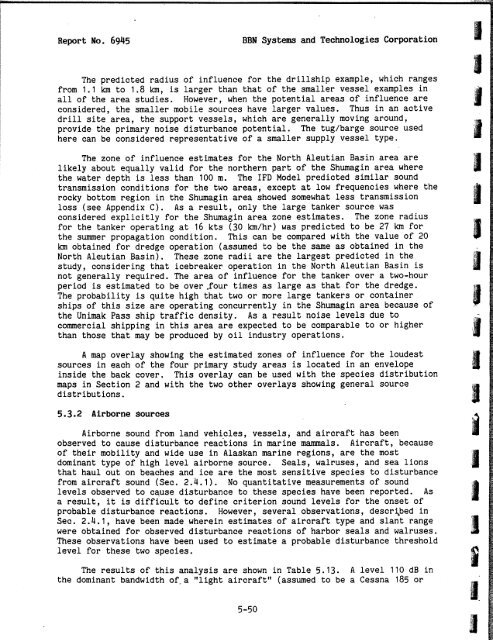Analysis and Ranking of the Acoustic Disturbance Potential of ...
Analysis and Ranking of the Acoustic Disturbance Potential of ...
Analysis and Ranking of the Acoustic Disturbance Potential of ...
You also want an ePaper? Increase the reach of your titles
YUMPU automatically turns print PDFs into web optimized ePapers that Google loves.
Report No. 6945<br />
BBN Systems <strong>and</strong> Technologies Corporation<br />
The predicted radius <strong>of</strong> influence for <strong>the</strong> drillship example, which ranges<br />
from 1.1 km to 1.8 km, is larger than that <strong>of</strong> <strong>the</strong> smaller vessel examples in<br />
all <strong>of</strong> <strong>the</strong> area studies. However, when <strong>the</strong> potential areas <strong>of</strong> influence are<br />
considered, <strong>the</strong> smaller mobile sources have larger values. Thus in an active<br />
drill site area, <strong>the</strong> support vessels, which are generally moving around,<br />
provide <strong>the</strong> primary noise disturbance potential. The tug/barge source used<br />
here can be considered representative <strong>of</strong> a smaller supply vessel type.<br />
The zone <strong>of</strong> influence estimates for <strong>the</strong> North Aleutian Basin area are<br />
likely about equally valid for <strong>the</strong> nor<strong>the</strong>rn part <strong>of</strong> <strong>the</strong> Shumagin area where<br />
<strong>the</strong> water depth is less than 100 m. The IFD Model predicted similar sound<br />
transmission conditions for <strong>the</strong> two areas, except at low frequencies where <strong>the</strong><br />
rocky bottom region in <strong>the</strong> Shumagin area showed somewhat less transmission<br />
loss (see Appendix C). As a result, only <strong>the</strong> large tanker source was<br />
considered explicitly for <strong>the</strong> Shumagin area zone estimates. The zone radius<br />
for <strong>the</strong> tanker operating at 16 kts (30 km/hr) was predicted to be 27 km for<br />
<strong>the</strong> summer propagation condition. This can be compared with <strong>the</strong> value <strong>of</strong> 20<br />
km obtained for dredge operation (assumed to be <strong>the</strong> same as obtained in <strong>the</strong><br />
North Aleutian Basin). These zone radii are <strong>the</strong> largest predicted in <strong>the</strong><br />
study, considering that icebreaker operation in <strong>the</strong> North Aleutian Basin is<br />
not generally required. The area <strong>of</strong> influence for <strong>the</strong> tanker over a two-hour<br />
period is estimated to be over-four times as large as that for <strong>the</strong> dredge.<br />
The probability is quite high that two or more large tankers or container<br />
ships <strong>of</strong> this size are operating concurrently in <strong>the</strong> Shumagin area because <strong>of</strong><br />
<strong>the</strong> Unimak Pass ship traffic density. As a result noise levels due to<br />
commercial shipping in this area are expected to be comparable to or higher<br />
than those that may be produced by oil industry operations.<br />
A map overlay showing <strong>the</strong> estimated zones <strong>of</strong> influence for <strong>the</strong> loudest<br />
sources in each <strong>of</strong> <strong>the</strong> four primary study areas is located in an envelope<br />
inside <strong>the</strong> back cover. This overlay can be used with <strong>the</strong> species distribution<br />
maps in Section 2 <strong>and</strong> with <strong>the</strong> two o<strong>the</strong>r overlays showing general source<br />
distributions.<br />
5.3.2 Airborne Sources<br />
Airborne sound from l<strong>and</strong> vehicles, vessels, <strong>and</strong> aircraft has been<br />
observed to cause disturbance reac'tions in marine mammals. Aircraft, because<br />
<strong>of</strong> <strong>the</strong>ir mobility <strong>and</strong> wide use in Alaskan marine regions, are <strong>the</strong> most<br />
dominant type <strong>of</strong> high level airborne source. Seals, walruses, <strong>and</strong> sea lions<br />
that haul out on beaches <strong>and</strong> ice are <strong>the</strong> most sensitive species to disturbance<br />
from aircraft sound (Sec. 2.4.1). No quantitative measurements <strong>of</strong> sound<br />
levels observed to cause disturbance to <strong>the</strong>se species have been reported. As<br />
a result, it is difficult to define criterion sound levels for <strong>the</strong> onset <strong>of</strong><br />
probable disturbance reactions. However, several observations, described in<br />
Sec. 2.4.1, have been made wherein estimates <strong>of</strong> aircraft type <strong>and</strong> slant range<br />
were obtained for observed disturbance reactions <strong>of</strong> harbor seals <strong>and</strong> walruses.<br />
These observations have been used to estimate a probable disturbance threshold<br />
level for <strong>the</strong>se two species.<br />
The results <strong>of</strong> this analysis are shown in Table 5.13. A level 110 dB in<br />
<strong>the</strong> dominant b<strong>and</strong>width <strong>of</strong>-a "light aircraft" (assumed to be a Cessna 185 or
















